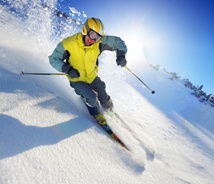Know Your Ability and Prevent Knee Injuries on the Slopes
- < Back to Articles
- April 2, 2014

For over a century, downhill skiing has been at the forefront of popular, recreational winter activities. Like any other specialty sport, skiing comes with a unique set of physical demands and risks. While continuing advancements in equipment have created decreasing trends in most ski injuries, knee injuries have remained static, and in some studies, increased in the past forty years. It is estimated that there are approximately 100,000 acute knee injuries in North America in recreational skiers annually. Studies have identified four common mechanisms by which most of these injuries occur:
• Valgus-external rotation (falling forward and losing control of the skis)
This commonly occurs at high speeds when the inside edge of one of the skis catches the snow, causing the skier to fall forwards and the lower leg attached to the ski to rotate outwards. Studies have found that this is often the most common mechanism of knee injury in recreational skiers.
• Hyperextension/internal rotation (center of gravity shifts forward as the skier begins to lose control)
This occurs when one of the skis catches the snow and rotates inward into the common “snowplow” position and the knee hyperextends, causing injury.
• Boot induced mechanism (landing afterlosing contact with the ground such as after a jump)
Instead of a proper landing, the back edge of a ski makes contact with the snow first, causing the top of the boot to force the lower leg forward relative to the upper leg, isolating and focusing the landing force on the knee joint.
• Phantom foot mechanism (falling backwards)
In this injury, the skier falls backwards in a seated position, placing the hips below the knees and hyperflexes the knee. As modern ski boots become more rigid, this injury is becoming more common compared to the use of previous, more flexible boots.
Like any other recreational activity that has potential hazards, the key to preventing knee injuries while skiing is to enjoy the sport safely and conservatively. Many of the above injuries are the result of high speeds and/or aggressive skiing. A skier being able to gauge his or her own ability level and ski accordingly is perhaps the most important factor in minimizing injuries..



